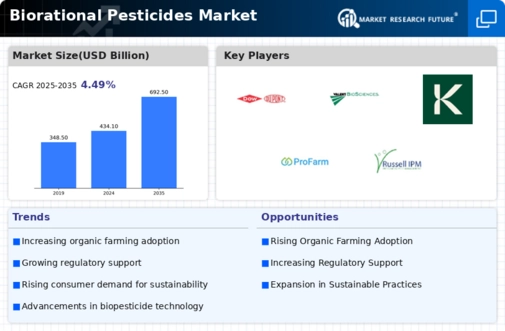Top Industry Leaders in the Biorational Pesticides Market
 Biorational Pesticides Market Outlook
Biorational Pesticides Market Outlook
Biorational Pestcides Market is experiencing a dynamic and competitive landscape driven by the increasing demand for sustainable and environmentally friendly pest management solutions. Key players in this market are employing diverse strategies to gain a competitive advantage and cater to the growing need for safer alternatives to traditional chemical pesticides. Among the prominent companies, Bayer Crop Science stands out as a major player that has been actively involved in the development and promotion of biorational pesticides.
Key Players in the Global Biorational Pesticides Market
- Bayer AG (Germany)
- Syngenta AG (Switzerland)
- Monsanto Bioag (US)
- BASF SE (Germany)
- Dowdupont (US)
- Valent Biosciences (Canada)
- Isagro SAP (Italy)
- Koppert (The Netherlands)
- Marrone Bio Innovations (US)
- Russell IPM (UK)
In the competitive landscape, Marrone Bio Innovations is making significant strides as a key player specializing in biorational crop protection. The company's portfolio includes bioinsecticides, biofungicides, and nematicides, emphasizing biological solutions for pest and disease management. Marrone Bio Innovations' strategic partnerships and collaborations with research institutions further highlight its commitment to advancing biorational technologies and expanding its market presence.
Market share analysis in the Biorational Pesticides Market is influenced by several factors, with product efficacy, regulatory compliance, and market reach playing critical roles. The ability of companies to address specific pest-related challenges faced by farmers and offer tailored solutions contributes to their market share. Bayer's extensive global presence and Syngenta's focus on integrated pest management strategies contribute significantly to their competitive positions. Additionally, pricing strategies, brand reputation, and effective marketing campaigns play crucial roles in influencing market share in this rapidly evolving market.
The emergence of new and innovative companies is shaping the Biorational Pesticides Market, introducing competition and fostering advancements in the field. Start-ups like Vestaron Corporation are gaining attention with their focus on peptide-based bioinsecticides. These companies leverage cutting-edge technologies to develop targeted and sustainable solutions for pest control. The rise of such emerging players underscores the market's shift towards precision and environmentally friendly alternatives, challenging traditional norms and promoting a more sustainable approach to agriculture.
Industry news in the Biorational Pesticides Market reflects ongoing developments and innovations. The collaboration between Corteva Agriscience and Vestaron Corporation to develop and commercialize peptide-based bioinsecticides represents a noteworthy milestone. This partnership signifies a concerted effort to bring novel biorational solutions to the market, addressing the demand for effective and sustainable pest control methods. Such collaborations showcase the industry's commitment to advancing research and development to meet the evolving needs of agriculture and environmental sustainability.
Current investment trends in the Biorational Pesticides Market underscore the growing importance of research and development, technology integration, and market expansion. Companies are allocating resources to enhance the efficacy of biorational products, explore new formulations, and expand their product portfolios. Investments in biotechnological advancements, such as the use of genetic engineering for pest resistance, are gaining traction, reflecting a broader industry commitment to staying at the forefront of innovation in biorational pest control.
Company News
In the year 2021, Valent BioSciences, a renowned global leader in Biorational solutions, introduced MetaLarv XRP to its product lineup. This innovative product from Valent utilizes Triple Release technology to effectively safeguard against mosquitoes. MetaLarv XRP not only acts as a deterrent to mosquitoes but also plays a crucial role in eliminating breeding grounds associated with the West Nile virus, contributing to comprehensive pest control measures.









